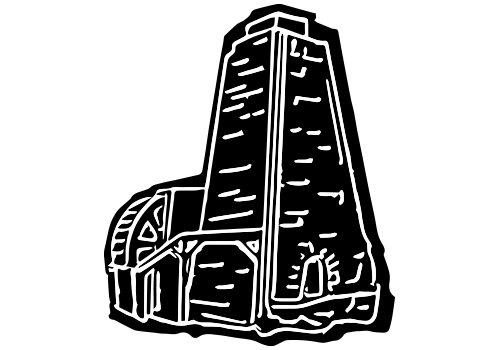Letter O represents the heritage and significance of the railroad

The Chesapeake and Ohio Railway in Clifton Forge Element
The histories of the C&O Railway and Clifton Forge could not be more closely linked. The C&O was Clifton Forge’s primary reason to exist. The C&O came to this area in 1857, when the western terminus of the Virginia Central was Jackson’s River Station (located approximately where Oakland church is, just west of Selma). Some small facilities were located in what was then known as Williamson’s. In the 1880’s, the town became genuinely important as a terminal and division point. In 1889, the C&O built a large repair and service shop here. The expansion of the C&O’s coal business and the increase in traffic made Clifton Forge the second largest and most important service, classification, and gathering point for the railway. The town was named by the railroad, after a forge just to the southeast of town on the James River line. During the 1890’s, the railroad owned most of the land in town and developed it and sold lots to the many people coming here to work on the railroad. Passenger stations along the line prominently displayed a large sign, framed in black, noting the altitude of the station's location. Hence, Clifton Forge displayed the sign 'ALT 1065' signifying 1065-feet above sea level.

I LOVE CLIFTON FORGE Element
Scenic, busy, friendly—Clifton Forge has greeted visitors with this motto for over 60 years. It was originally named Williamson after the founding family who settled here as pioneers in the early 1800s. For a time, it was the center of the iron ore industry in Virginia. By 1857, the railroad had found its way here, and when the village became a town in 1884, it adopted the name Clifton Forge from a nearby iron furnace. It was a strategic location on the Chesapeake and Ohio Railroad, which developed a large railroad yard and locomotive and repair shops. It was a classic railroad boomtown and was a thriving community until the shops closed in the late 1980s. Today, Clifton Forge remains a strong community of proud citizens and is undergoing renewal and revitalization that focuses on its rich natural beauty and railroad and architectural heritage.
https://drive.google.com/file/d/1TbfC7PEkHafnuJjy3fUxwer51N_tvAw0/view?usp=sharing

Stage Coach Element
Travel in early times was rough and slow over unimproved trails, roads, and rivers. The canals of the late 18th and early 19th century offered an answer, but it was the railroads of the later 19th century that revolutionized transportation and reshaped the world. Stagecoaches took passengers from canal or railroad terminals onward. Coaches traveled on the James River & Kanawha Turnpike, an extension of the canal westward The Jackson River Depot was located 2 miles from here. It marked the western terminus of the Virginia Central Railroad, which extended 200 miles from Hanover Junction north of Richmond. Located just east of the Kanawha Pass of the Allegheny Mountains, the depot, the railroad, and the Jackson River were strategically important as logistical links to Tennessee and served as the "back door" gateways to the Shenandoah Valley and Central Virginia.
https://www.gallopinghome.com/virginia-by-stagecoach/
https://historicalmarkerproject.com/markers/HM21FM_jackson-river-depot_Low-Moor-VA.html
https://drive.google.com/file/d/1E06Sg3YMyXk3vXgFlxnwO1SnhOhT2kBy/view?usp=sharing

Iron Ore Element
There were scores of mines and furnaces (often called forges) in operation surrounding Clifton Forge before and in the decades following the Civil War.
Once the Virginia Central and later C&O were available for transportation the iron making of the Alleghany Highlands region expanded and major furnaces expanded or were built. During the 1890s another boom time in the industry foretold a bright future, but this soon dimmed with the discovery of ore in the western United States, and the iron era in Virginia declined and disappeared.
The iron industry was important to the growth of our nation because a reliance on imported iron goods such as tools, nails, and ammunition would have been very costly to the growing colonies. As a result of the British Iron Act of 1750, which permitted the duty-free import of iron into Great Britain, forges and furnaces began operation in all the colonies except Georgia. The Valley of Virginia was particularly suited to iron mining because it contained iron-rich ore, limestone for flux, and plenty of hardwood forests for fuel. In fact, during the 1830s and 1840s there were over 75 furnaces in operation in the Ridge and Valley region (Russ, McDaniel, and Wood 1995:5)
https://thediggings.com/usa/virginia/alleghany-va005
http://www.us-mining.com/virginia/alleghany-county/iron-mines

Chesapeake and Ohio Railway Shops Element
When the first train arrived in Jackson's River Station on July 10th, 1857, the western terminus of the Virginia Central consisted of little more than a refueling station for wood-burning steam engines and a station house for employees and passengers. However, by the middle of the 1940s, the rail yard beyond provided work for nearly 2,000 employees. It is estimated that as many as 1,400 workers per day went to work on the rail yard. Shift changes even necessitated the use of a traffic light to ensure safety. Alas, the 1950s saw the shift towards diesel locomotives and with it the shifting of CSX repair shop away from the town. The years saw the town and the railroad grow together, and today Clifton Forge takes great pride in its founding role in the nation's rail system.
https://drive.google.com/file/d/1Q8Ec3OYyS73jrmo4mm_1Nv6hyLimYk_1/view?usp=sharing
https://historicalmarkerproject.com/markers/HM21FE_c-o-railroad-shops_Clifton-Forge-VA.html

Pacemaker Element

(1924–2009)
The C & O, Emmett Memorial and Alleghany Regional hospitals in the Alleghany Highlands offered Dr. Ballou the perfect place to practice specialized medicine in the rural setting he always desired, believing that people in such areas deserved the high quality care enjoyed by urban residents. He felt great satisfaction in the establishment of a pulmonary care unit and clinic as well as an intensive care unit in the hospitals he served as well as being a part of the 1959 team that supplied the first pacemaker given a patient (H.W. Hoffman of Clifton Forge) in the state of Virginia. An associate of Jackson River Internists, he also served as Clinical Associate of Medicine, University of Virginia School of Medicine. In 1973 he was awarded the Virginia Tuberculosis and Respiratory Disease Association’s Nora Spencer Hammer Award for significant contributions to the programs against those diseases.

Chesapeake & Ohio Railway Employee/Community Hospital Element
The Clifton Forge hospital opened its doors in December, 1897, in the refurbished Gladys Inn. In the heyday of the C&O Hospital Association, several trains from both east and west would arrive at the Clifton Forge station, disgorging employees and their families from as far west as Ludington, Michigan and as near as Eagle Rock, Virginia, 15 miles away. They would then proceed to the hospital three-fourths of a mile distant and present themselves at the admitting desk. Here, after simply presenting their Hospital Association card, they were admitted without any previous appointment, for their yearly checkup or post-surgical follow-up. Often they were accompanied by their wives, the annual medical checkup being a yearly family vacation.
Clifton Forge acted as a community hospital for the area along the Virginia-West Virginia border, which embraced five to six counties. It rapidly became established that if a person became acutely ill he could always to go the “C&O” and “someone would always take care of you.”
https://drive.google.com/file/d/16ONZHPPjFbkYJz90wNmIxP-ggAXjfuPg/view?usp=sharing

Area Iron Ore Furnaces and Operations Element
The iron industry was important to the growth of our nation because a reliance on imported iron goods such as tools, nails, and ammunition would have been very costly to the growing colonies. As a result of the British Iron Act of 1750, which permitted the duty-free import of iron into Great Britain, forges and furnaces began operation in all the colonies except Georgia. The Valley of Virginia was particularly suited to iron mining because it contained iron-rich ore, limestone for flux, and plenty of hardwood forests for fuel. In fact, during the 1830s and 1840s there were over 75 furnaces in operation in the Ridge and Valley region (Russ, McDaniel, and Wood 1995:5).
Very important among the many furnaces was the Longdale Mining Complex located near the headwaters of the James River, three miles due east of the confluence of the Cowpasture River and Simpson Creek in a valley formed by Brushy and North mountains. The complex is in the Ridge and Valley province of the Appalachian Highlands (Fenneman 1938:195-202).
DONATE TODAY!
You can donate two ways! Either mail a check to:
P.O. Box 631
Clifton Forge, VA 24422
Checks made payable to the Town of Clifton Forge and add 'LOVE SIGN' to memo line.
Or fill out the form below and donate online!
contact us





